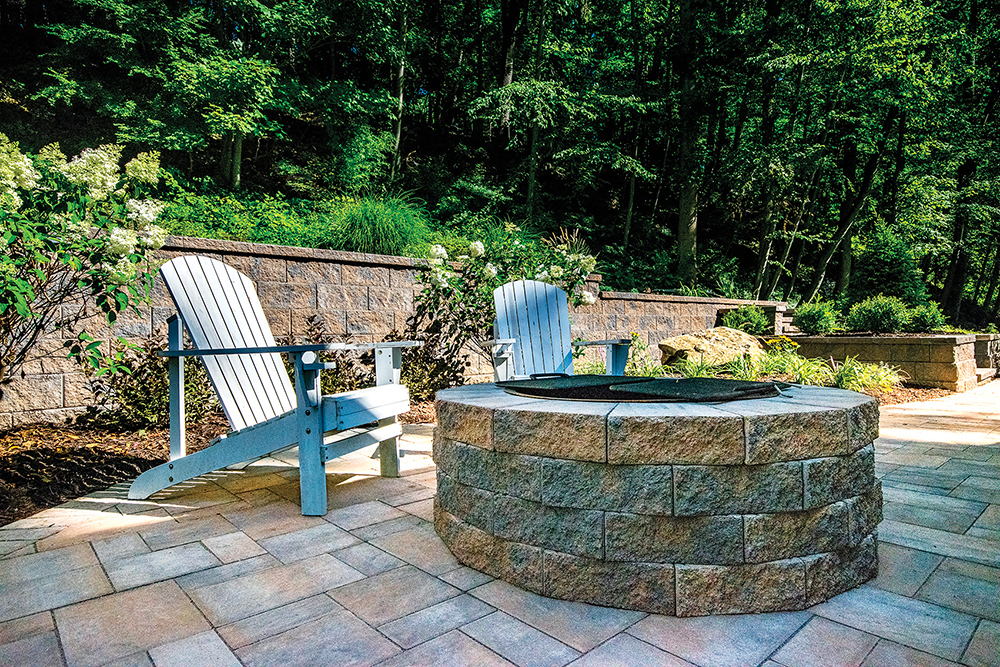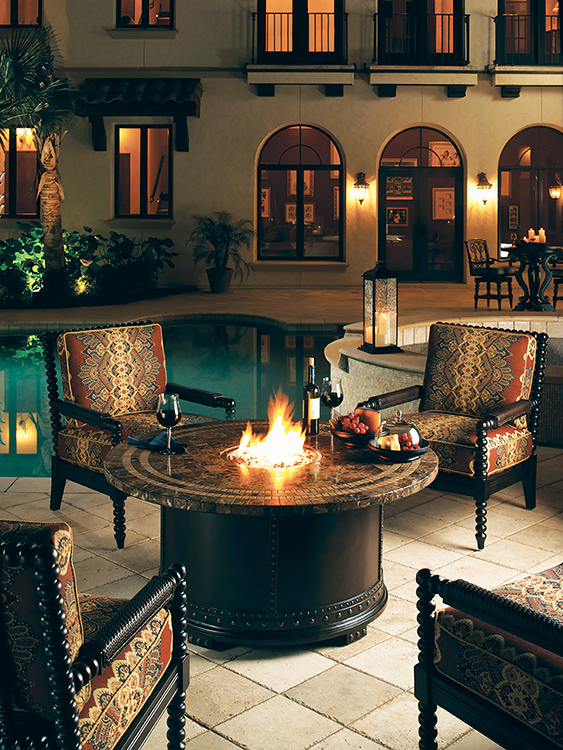Tips from a Pro: Choosing an Outdoor Fire Feature
Writer Meg Fox | Designer Kris Holland | Location Rockaway, NJ
Designed and built by Black River Landscape Management with Cambridge Pavingstones, this fire pit effortlessly blends with the landscape, patio and retaining wall.
Gas or wood-burning? Freestanding or custom? Learn what would suit you best.
Outdoor spaces have come into their own as legitimate rooms in the American home. According to a 2018 survey by the International Casual Furnishings Alliance, fire pits—along with dining sets, lounge chairs and lighting—rank among consumers’ top four planned purchases for the backyard. The fire category alone (fire pits, fireplaces and fire tables) continues to increase in popularity and gain momentum in the industry, says Jackie Hirschhaut, executive director of ICFA. “You just can’t beat a fire element for creating ambiance.”
This fall, as the days get shorter and the nights grow cooler, we talk with Kris Holland, founder of Black River Landscape Management Inc., a full-service landscaping company based in Rockaway, for his take on adding a fire element to outdoor living areas.
Design NJ: How popular are outdoor fire features with your clients?
Kris Holland: As more people invest in their backyards and view them as a second living space, fire pits make terrific gathering spots for family and friends and are growing in popularity for their convenience, function and low maintenance. Essentially, they can be used in the spring, summer, fall and even warmer winter days. Remember that 75-degree day last February? Custom-built units in particular make a great investment and add an element of luxury living.

The Kingsdown Sedona fire pit surface is crafted from Spanish Café Emperador marble with 1-inch copper inlays that catch the glow of the fire light and provide ambience desired for a restful evening outdoors. New from Lexington’s Tommy Bahama Home collection.
DNJ: What are some things to consider before choosing a fire element?
KH: If you are building a custom unit, decide whether you want gas or wood-burning. Gas is more expensive and requires a plumber to install a dedicated gas line.
DNJ: Do you prefer a wood-burning fireplace over gas-powered?
KH: It depends on what you want. You can run gas lines to your fire pit and never have to clean out any ash. They do cost more to run, though, and produce less heat than wood-burning fires. Gas-powered fire pits may use propane tanks or your home’s natural gas source and provide a level of control you won’t get with wood. On the other hand, some people prefer to burn wood for the aroma, ambience and nostalgic feel of a campfire. Everyone loves roasting marshmallows and making s’mores!
DNJ: What types of fire pits or fire tables are currently available?
KH: There are two types of fire pits. The first is a freestanding unit that you simply purchase and place in your yard. The benefit is that there is no down time. The other is a custom design, built by a company like ours in a custom size and shape—like one with a curved seat wall—that fits the backyard perfectly and is built with a stone color that matches your home. It becomes a statement piece and adds value to your property. The downside to some? It could take a few weeks to a few months to build.
DNJ: Have you noticed advancements in the design or technology of fire tables or fire pits?
KH: When I first got into the business, fire pits were very simple. They were basically a collection of rocks and a little bit of concrete in a circle. They have evolved since then. Some have marble tops and are designed so ashes can’t escape and become a potential fire risk. Homeowners also are building sophisticated, contemporary models that feature both a fire element and a water element in sleek rectangular shapes or even ones that incorporate a built-in waterfall.
DNJ: What is trending now?
KH: Gas fire pits—both custom and freestanding—are trending. There’s no need to buy wood or deal with the hassle of starting and maintaining a fire. You just push a button.
DNJ: When building custom, what are some of your go-to materials?
KH: Cambridge Pavingstones® are my go-to because they come in a variety of shapes and colors, allowing homeowners to pick a look that matches their home. They also withstand the hot New Jersey summers and cold snowy winters. Cambridge also makes great, affordable gas fire pits.
DNJ: Any important safety considerations?
KH: Gas is much safer than wood-burning fire features when installed properly. If you go with wood-burning, be sure to keep it at least 10 feet away from any structure. A fire pit should always be put on a non-flammable and heat-resistant source such as brick or stone. If you have very small kids, you may want to use a spark screen. Always supervise your children when there is an open flame.
DNJ: What’s the best way to care for a fire feature and protect your investment?
KH: Clean out the ashes in a wood-burning unit periodically to keep surrounding areas from becoming stained or discolored. If you have a gas fire pit, protect it in the winter with a tarp or custom cover to protect the mechanics and keep any exposed metal from rusting.
